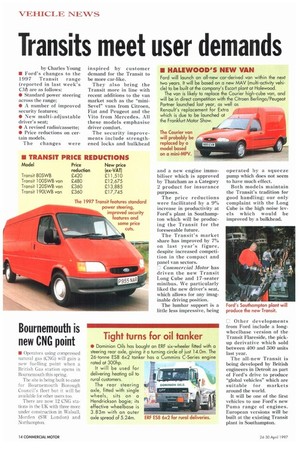Transits meet user demands
Page 16

If you've noticed an error in this article please click here to report it so we can fix it.
by Charles Young • Ford's changes to the 1997 Transit range (reported in last week's CM) are as follows: • Standard power steering across the range; • A number of improved security features; • New multi-adjustable driver's seat; • A revised radio/cassette; • Price reductions on certain models. The changes were inspired by customer demand for the Transit to be more car-like.
They also bring the Transit more in line with recent additions to the van market such as the "miniSevel" vans from Citroen, Fiat and Peugeot and the Vito from Mercedes. All these models emphasise driver comfort.
The security improvements include strengthened locks and bulkhead and a new engine immobiliser which is approved by Thatcham as a Category 2 product for insurance purposes.
The price reductions were facilitated by a 9% increase in productivity at Ford's plant in Southampton which will be producing the Transit for the foreseeable future.
The Transit's market share has improved by 7% on last year's figure, despite increased competition in the compact and panel van sectors.
L1 Commercial Motor has driven the new Transit Long Cube and 17-seater minibus. We particularly liked the new driver's seat, which allows for any imaginable driving position.
The lumbar support is a little less impressive, being operated by a squeeze pump which does not seem to have much effect.
Both models maintain the Transit's tradition for good handling; our only complaint with the Long Cube is the high noise levels which would be improved by a bulkhead.
7 Other developments from Ford include a longwheelbase version of the Transit Flareside, the pickup derivative which sold between 400 and 500 units last year.
The all-new Transit is being developed by British engineers in Detroit as part of Ford's drive to produce "global vehicles" which are suitable for markets around the world.
It will he one of the first vehicles to use Ford's new Puma range of engines. European versions will be built at the existing Transit plant in Southampton.




















































































































